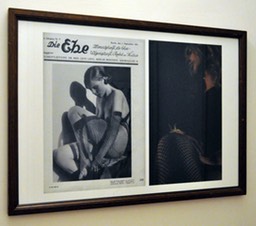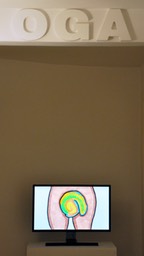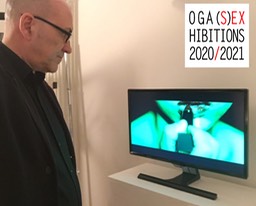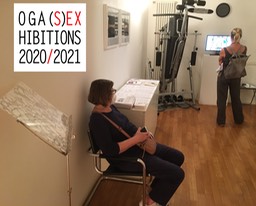Exhibition: THAT BEAUTIFUL QUEER MESS
Artists: Shanghai Chang, Steven Fraser, Werther Germondari, Jean-René Leblanc, Hugo Ljungbäck, Souvik Majumdar, Chelsea Poe e Courtney Trouble, Gabriel Dietrich, Gil e Pedro Inoue, Tino Monetti, Lapo Mamoli, Malvina Tessitore, Giulia Storchi.
Playing irreverently with the title of the famous book by Carlo Emilio Gadda ‘Quer pasticciaccio brutto di via Merulana’ (translated into English in 'That awful mess on Via Merulana'), the Ospizio Giovani Artisti exhibits, two years after the last one (The Queer Collection), another exhibition on the universe of orientations and gender identities that do not identify with 'traditional' sexual labels.
Giocando irrispettosamente con il titolo del famoso romanzo di Carlo Emilio Gadda, l’Ospizio Giovani Artisti espone, a distanza di due anni dall’ultima (La Collezione Queer), un’altra mostra sull’universo di orientamenti e identità di genere non identificabili nelle etichette sessuali ‘tradizionali’.
Shanghai Chang (Phnom Penh, Cambodia, 1996). Graduated with Bacholor Degree (Hons) Arts in Fashion Design and Photography. Beside being co-founder and contemporary artist in HOMELESS Artists Collective, Shanghai is a self-taught Experimental Filmmaker inspired by Psychological & Psychedelic genres; dealing with Gender Identity, Sexuality, Fetish, Submission, Lust, Love, Hate, Anger, Anxiety, Addiction, Obsession and Dark thoughts through experimental collage of disturbing, provocative metaphors moving images with hunting voices, sounds and music.
Steven Fraser (Edinburgh, GB, 1981) is an animator, writer and theatre-maker who creates short films and performances that are designed for adults who express neurodiverse behaviours, but can be enjoyed by anyone. I make inventive use of animation, puppetry and kinetic art to present unique and distinctive art. I identify as queer and take a queer perspective within my work. Steven is autistic, live with Asperger’s syndrome and is particularly interested in the intersectionality of autism and queerness.
Werther Germondari (Rimini, Italy, 1963) Visual artist, performer and filmmaker. Interested in innovative experimental dynamics that are neo-conceptual and situational, characterized by a taste for the ironic and surreal, Germondari has experimented for 35 years through many different expressive media (from painting to installations, photography to film, videos to live performance). Germondari's works have also been shown in solo exhibitions where he focuses on hidden elements highlighted in styles. In 2013 he founded the Ospizio Giovani Artisti.
Jean-René Leblanc (Montréal, Canada, 1967) is a visual artist and an Associate Professor of Digital Arts at the University of Calgary in Canada. “The “Trans” series is base on historical imagery recovered from and related to the Institute for Sexual Science founded in Berlin in 1919 by physician Dr. Magnus Hirschfeld. The institute was pillaged and destroyed by the Nazis in 1933. “In both my contemporary portraits and Hirschfeld’s historical photographs, the viewer is challenged to rethink assumptions about gender dimorphism. Yet while the contemporary imagery highlights, intimacy, sexual display, performance, and self-exploration, Hirschfeld historical imagery was attempting to create scientific distance and provide evidence for his theory of distinct sexual types. I believe that the conversation produced out of the contrast between these two views presented as diptychs can provoke fruitful discussion and insights into both the historical and the present-day understanding of sexuality and its public display” (J.R.L.).
Hugo Ljungbäck (Hässleholm, Sweden, 1996) is a video artist and film curator. His video in the exhibition The artist tries to cope with the pressure and coercion young gay men experience to live up to masculine beauty ideals, please their partners, and send nude pictures of themselves: “my work regularly explores queer themes, infidelity, sexual abuse, and coercion through the lens of the personal, offering portraits of the privately hidden, the truly intimate, the often unflattering, and the unseen”.
Souvik Majumdar (Calcutta, India, 1996) is a visual artist. “This work very close to my heart, the play of the shadow interests me, I am present, but not present, at the same time. As I am working on the negative filter I used it here in another frame, somehow I find the black become white in negatives, it also interests me. I don’t know” negative “may be the way of looking also, the way people see this kind of work. I didn’t have any plan of doing it, it came while I was working” (SM.).
Chelsea Poe (XXXXX, Ohio, USA, 1993) is involved at the forefront of the transgender equality movement and has launched several social awareness campaigns focused on transgender discrimination. She began her career in the porn industry in her twenties as a photographer. Courtney Trouble (XXXXX, Washington, USA, 1982) is a multi-disciplinary artist and performer whose work focuses primarily on the representation of the queer, lesbian and homosexual world from a very intimate point of view, which flows professionally into the world of pornography.
Gabriel Dietrich, Gil e Pedro Inoue, Tino Monetti (Brasile) are the authors of the music video "Etérea". In this project, the singer and songwriter Criolo, known for his rap and samba, switches to electronic beats to highlight the issue of LGBT phobia and culture in Brazil. Performed by 8 performers from different queer collectives in São Paulo, the project also has a behind-the-scenes documentary, where they explain the struggles and poetics of their lives.
Lapo Mamoli, Malvina Tessitore, Giulia Storchi (Italy) are the young authors of the interesting video 'Open Up'.
————————————
Shanghai Chang (Phnom Penh, Cambogia, 1996). Laureat* in arte, fashion design e fotografia. Oltre ad essere co-fondatore e artista contemporaneo dell’HOMELESS Artists Collective, Shanghai è un regista autodidatta sperimentale ispirato dai generi psicologici e psichedelici; suo intento è affrontare l'identità di genere, la sessualità, il fetish, la sottomissione, la lussuria, l'amore, l'odio, la rabbia, l'ansia, la dipendenza, l'ossessione e i pensieri oscuri; un collage sperimentale di metafore inquietanti e provocatorie, realizzato attraverso immagini, voci, suoni e musica.
Steven Fraser (Edinburgh, GB, 1981) è un animatore, scrittore e regista teatrale che crea cortometraggi e spettacoli pensati per adulti che esprimono comportamenti neurodiversi, ma che possono comunque essere graditi. Fa un uso creativo dell'animazione e della kinetic art. Si identifica come queer ed utilizza una prospettiva queer anche nel suo lavoro. Steven è autistico, vive con la sindrome di Asperger ed è particolarmente interessato all'intersezionalità tra queer e autismo.
Werther Germondari (Rimini, 1963) Artista visivo, performer e filmmaker. Attento a dinamiche innovative sperimentali neo-concettuali che si caratterizzano per un gusto ironico e surreale, svolge dai primi anni ottanta una ricerca attraverso numerosi media espressivi. Ha partecipato a esposizioni in gallerie private e spazi sperimentali internazionali, alternando installazioni d’ambiente, videowork e atti performativi, focalizzando l’attenzione su elementi nascosti, attinenti a una visione reale, sociale e politica. Nel 2013 ha ideato l’Ospizio Giovani Artisti.
Jean-René Leblanc (Montréal, Canada, 1967) è artista visivo e professore associato di arti digitali all'Università di Calgary, in Canada. La sua serie "Trans", esposta nella mostra, è basata su immagini storiche recuperate e relative all'Istituto di Scienza Sessuale fondato a Berlino nel 1919 dal medico Dr. Magnus Hirschfeld. L'istituto fu saccheggiato e distrutto dai nazisti nel 1933. “Sia nei miei ritratti contemporanei che nelle fotografie storiche di Hirschfeld, lo spettatore è sfidato a ripensare gli assunti sul dimorfismo di genere. Tuttavia, mentre le immagini contemporanee mettono in evidenza l'intimità, l'esibizione sessuale, la performance e l'auto-esplorazione, le immagini storiche di Hirschfeld cercavano di creare una distanza scientifica e di fornire prove per la sua teoria dei tipi sessuali distinti. Credo che la conversazione prodotta dal contrasto tra questi due punti di vista presentati come dittici possa provocare una discussione fruttuosa e intuizioni sia nella comprensione storica che in quella attuale della sessualità e della sua esposizione pubblica” (J.R.L.).
Hugo Ljungbäck (Hässleholm, Svezia, 1996) è un video artista svedese, curatore cinematografico che vive a Milwaukee, negli USA. Le sue opere esplorano la soggettività queer attraverso il cinema sperimentale e la video arte. “Il mio lavoro esplora regolarmente i temi queer, l'infedeltà, l'abuso sessuale e la coercizione attraverso la lente del personale, offrendo ritratti del privato nascosto, del veramente intimo, del spesso non lusinghiero e del non visto” (H.L.).
Souvik Majumdar (Calcutta, India, 1996), è un artista visivo. Così descrive il suo video in mostra: “è un lavoro video che mi sta molto a cuore, il gioco dell'ombra mi interessa, sono presente, ma non presente, allo stesso tempo. Siccome sto lavorando sul filtro negativo l'ho usato qui in un altro fotogramma, in qualche modo trovo il nero che diventa bianco nei negativi, anche questo mi interessa. Non so, "negativo" può essere anche il modo di guardare, il modo in cui la gente vede questo tipo di lavoro. Non avevo nessun piano per farlo, è venuto mentre stavo lavorando.
Chelsea Poe (XXXXX, Ohio, USA, 1993) è impegnata in prima linea nel movimento per la parità transgender e ha lanciato diverse campagne di sensibilizzazione sociale incentrate sulla discriminazione transgender. Ha iniziato la sua carriera nell'industria pornografica a vent’anni come fotografa. Courtney Trouble (XXXXX, Washington, USA, 1982) è un’artista multidisciplinare e performer, il cui lavoro è incentrato principalmente sulla rappresentazione del mondo queer, lesbico e omosessuale da un punto di vista molto intimo, che sfocia professionalmente nel mondo pornografico.
Gabriel Dietrich, Gil e Pedro Inoue, Tino Monetti (Brasile) sono gli autori del video musicale "Etérea". In questo progetto, il cantante e cantautore Criolo, noto per il suo rap e samba, passa ai beat elettronici per mettere in luce il tema della fobia e della cultura LGBT in Brasile. Interpretato da 8 performer provenienti da diversi collettivi queer di San Paolo, il progetto ha anche un dietro le quinte documentaristico, dove essi spiegano le lotte e la poetica delle loro vite.
Lapo Mamoli, Malvina Tessitore, Giulia Storchi (Italia) sono i giovanissimi autori dell’intrigante video ‘Open Up’ .










































